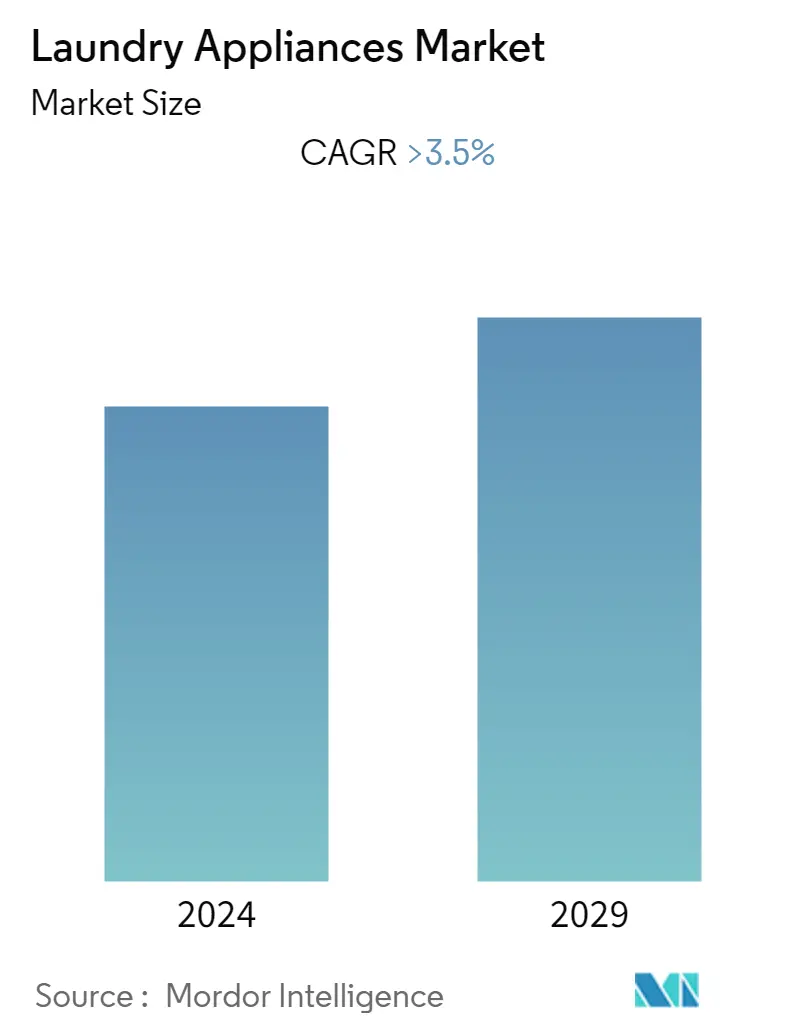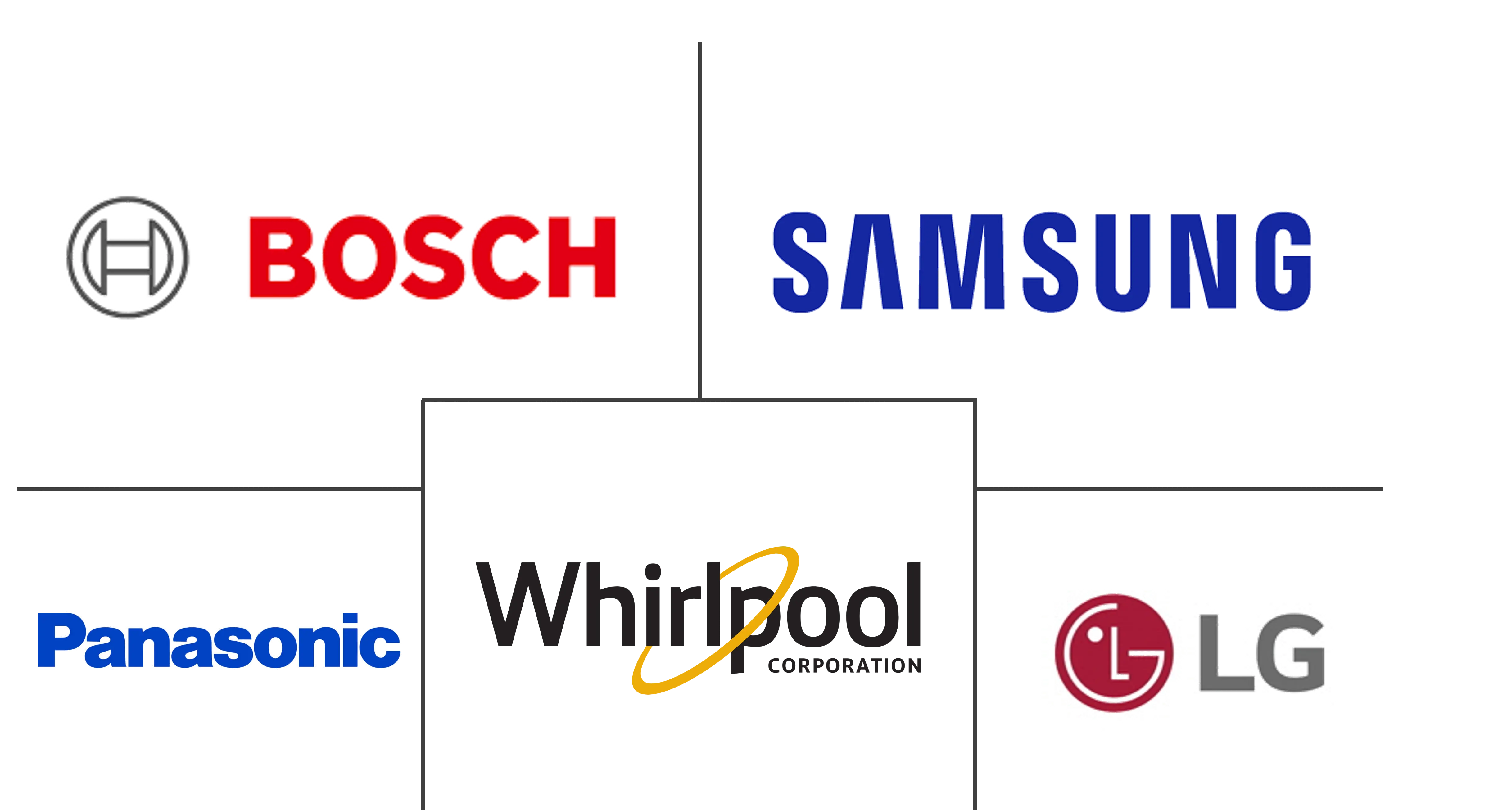Market Size of Laundry Appliances Industry

| Study Period | 2024 - 2029 |
| Base Year For Estimation | 2023 |
| CAGR | 3.50 % |
| Fastest Growing Market | Asia Pacific |
| Largest Market | Asia Pacific |
| Market Concentration | Low |
Major Players
*Disclaimer: Major Players sorted in no particular order |
Laundry Appliances Market Analysis
The global laundry appliances market is estimated to be valued at USD 80.3 Billion in the current year and is expected to register a CAGR of 3.5% during the forecast period.
Laundry appliances are those devices that are used to clean clothes and textiles. The growth of the laundry appliances market is fuelled by factors such as the rising number of middle-class populations that can afford washing machines and dryers, increased disposable income, changing lifestyles, and an increased standard of living. A growing number of working women populations is also acting as a growth driver for the laundry appliances market. Trends include innovating to increase efficiency and energy efficiency, as well as water consumption, due to environmental guidelines highlighted by several governments. The smart appliances trend is pervasive through the usage of sensors and other components used in smart technology. This market, dependent on real estate growth, both purchase and rental refurbishing are also innovating for smaller appliances because of different housing arrangements across the world.
The growth of the market can be attributed to a number of factors, including the increasing penetration of smart homes in both emerging and developed regions, the rapid growth and development of the IT infrastructure, changing demographic preferences, and the need to protect the global environment from harmful effluents, including greenhouse gases and toxic waste. With brands catering to the needs of the millennials and Gen-Z generation, there are many opportunities in the market for smart home appliances. From high-end smart lights to cutting-edge AI-enabled smart faucets, the trend is promising for the future.
COVID-19 had a negative impact on washing machine manufacturers' sales. Supply chain disruptions and stopped manufacturing activities had a negative effect on manufacturers' sales, which held the market back. The recovery of the market can be attributed to the shift towards traveling & tourism to increase demand for laundry equipment.
Laundry Appliances Industry Segmentation
Home appliances are a wide range of devices, typically powered by electricity, that are primarily used in the domestic environment or for the execution of domestic tasks, such as cooking, cleaning, and preserving cold food. Domestic appliances, also referred to as home appliances, typically include white goods, such as refrigerators, air conditioning systems, washing machines, dryers, dryers, freezers, stoves, and water heaters
The Laundry Appliances Market is Segmented By Product (Washing Machine, Dryers, Electric Smoothing Irons, Other Products), By Technology (Automatic, Semi-Automatic/Manual, and Other Technologies), By Distribution Channel (Multi-brand Stores, Exclusive Stores, Online, and Other Distribution Channels), By Geography (North America, Europe, Asia-Pacific, Latin America, and the Middle East and Africa). The report offers market size and forecasts in value (USD) for all the above segments.
| Product | |
| Washing Machine | |
| Dryers | |
| Electric Smoothing Irons | |
| Other Products |
| Technology | |
| Automatic | |
| Semi-Automatic/ Manual | |
| Other Technologies |
| Distribution Channel | |
| Multi-brand Stores | |
| Exclusive Stores | |
| Online | |
| Other Distribution Channels |
| Geography | |
| North America | |
| Europe | |
| Asia-Pacific | |
| Latin America | |
| Middle East and Africa |
Laundry Appliances Market Size Summary
The laundry appliances market is experiencing steady growth, driven by factors such as increasing disposable incomes, urbanization, and the rising number of working women. These elements contribute to a higher demand for washing machines and dryers, as they offer convenience and efficiency in managing laundry tasks. The market is also witnessing a shift towards smart appliances, which incorporate advanced technologies like sensors and IoT integration, catering to the preferences of younger generations such as millennials and Gen-Z. This trend is further supported by the growing penetration of smart homes and the rapid development of IT infrastructure, which enhances the functionality and appeal of these appliances. Additionally, environmental concerns are prompting innovations aimed at improving energy and water efficiency, aligning with global sustainability goals.
The market landscape is characterized by the presence of major international players, alongside mid-size and smaller companies that are expanding their market presence through technological advancements and product innovations. The Asia Pacific region holds a significant share of the market, attributed to its large middle-class population, rapid urbanization, and the increasing demand for convenient laundry solutions. Despite challenges posed by the availability of laundry services and the impact of COVID-19 on supply chains, the market is poised for recovery and growth. Innovations such as ultrasonic technology and smart washing machines with integrated features are expected to drive future market expansion, offering consumers enhanced convenience and efficiency in their laundry routines.
Laundry Appliances Market Size - Table of Contents
-
1. MARKET INSIGHTS AND DYNAMICS
-
1.1 Market Overview
-
1.2 Market Drivers
-
1.3 Market Restraints
-
1.4 Value Chain / Supply Chain Analysis
-
1.5 Porter's Five Forces Analysis
-
1.5.1 Bargaining Power of Buyers/Consumers
-
1.5.2 Bargaining Power of Suppliers
-
1.5.3 Threat of New Entrants
-
1.5.4 Threat of Substitute Products
-
1.5.5 Intensity of Competitive Rivalry
-
-
1.6 Insights on Technological Innovations in the Market
-
1.7 Insights on Government Regulation in the Market
-
1.8 Impact of COVID-19 on the Market
-
-
2. MARKET SEGMENTATION
-
2.1 Product
-
2.1.1 Washing Machine
-
2.1.2 Dryers
-
2.1.3 Electric Smoothing Irons
-
2.1.4 Other Products
-
-
2.2 Technology
-
2.2.1 Automatic
-
2.2.2 Semi-Automatic/ Manual
-
2.2.3 Other Technologies
-
-
2.3 Distribution Channel
-
2.3.1 Multi-brand Stores
-
2.3.2 Exclusive Stores
-
2.3.3 Online
-
2.3.4 Other Distribution Channels
-
-
2.4 Geography
-
2.4.1 North America
-
2.4.2 Europe
-
2.4.3 Asia-Pacific
-
2.4.4 Latin America
-
2.4.5 Middle East and Africa
-
-
Laundry Appliances Market Size FAQs
What is the current Laundry Appliances Market size?
The Laundry Appliances Market is projected to register a CAGR of greater than 3.5% during the forecast period (2024-2029)
Who are the key players in Laundry Appliances Market?
Whirlpool Corporation, Samsung Electronics Co. Ltd, Panasonic Holdings Corporation, LG Corporation and Robert Bosch GmbH are the major companies operating in the Laundry Appliances Market.

